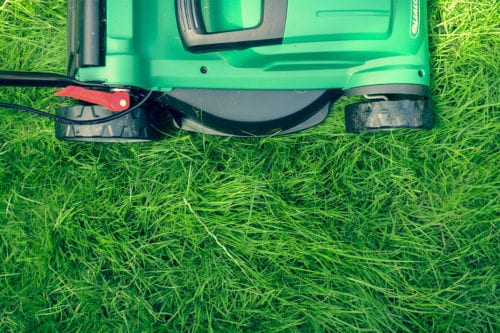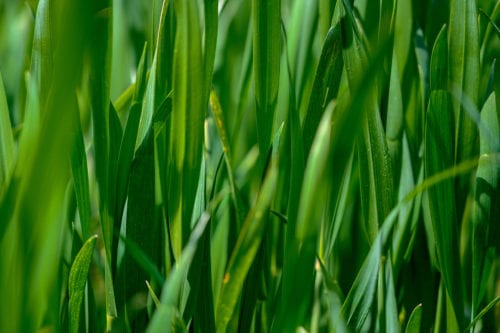Are You Spotting the Brown Patch Fungus?
Summer is here, and we all know what that means! Your lawn is going to serve as the pool party welcome mat and every Fourth of July celebration’s cookout.
Unfortunately, the seasonal heat can also mean some unwelcome visitors for your lawn: brown patch fungus.
Are you already seeing those tell-tale brown splotches or signs of other lawn diseases appearing across yours and your neighbors’ yards?
In the summer, you can come home at 6 in the evening, stroll through a perfectly green front lawn and wake up to a brown patch taking over.
Why is this?
While you were sleeping, a foliar disease started coloring your grass blades with brown leaf spots.
You might be thinking that a brown patch in your lawn might simply need more water. Or perhaps it’s not getting enough sun.
Actually, it’s none of the above, because there is a fungus in your lawn, and possibly a lot of it.
The culprit in question: brown patch fungus.
The Main Causes of Brown Patch Fungus
Brown patch fungus, also known as large patch disease, is a declining turf condition caused by a single species of fungus: Rhizoctonia.
Brown patches often occur in mid-to-late summer when the weather is hot and humid, making conditions perfect for the fungus to thrive.
The brown patch, ironically, doesn’t start off brown at all. The first signs of trouble are:
- A circular pattern of light yellow or orange discoloration appears in your grass
- The affected area eventually turns from orange to tan. Soon after, the tan color becomes darker, giving off a brown tint.
- If left unchecked, the brown patch will spread outwards and sometimes leave small green patches in the middle
The discoloration is caused when the fungus infects each leaf and causes them to rot.
Cool Season vs. Warm Season Grass Types
For many homeowners, having a green lawn for as long as possible is of primary importance, especially when it comes to treating brown patch fungus. The first decision is to choose the best grass type for your use and the climate of your region.
The two main types are warm season grass and cool season grass:
 Warm season grasses are varieties that are in active growth beginning in late spring and go dormant in early to mid-fall. So they “green” in late spring, when the nights begin to warm, and brown in mid-October (late September-October).
Warm season grasses are varieties that are in active growth beginning in late spring and go dormant in early to mid-fall. So they “green” in late spring, when the nights begin to warm, and brown in mid-October (late September-October).
These grasses are intolerant to shade. The more sun, the better! For homeowners living in places in the US where summer is hot, warm summer grasses are the best option.
Cool season grasses are varieties that are active in active growth (“green up”) much earlier in the growing season (mid-spring) and remain green in the fall before they go dormant in the late fall.
These grasses will tolerate a little shade, but need at least a 1/2 to 3/4 of a day of full sun. Without regular summer watering, they will go dormant in the heat of summer.
Cool season varieties will need significant water to keep them in active growth during the hotter months.
Brown patch fungus can affect all cool-season grasses, but it is detrimental to ryegrass and tall fescue. Brown patches also affect various warm-season grasses, including St. Augustine grass and Bermuda.
Treating Brown Patch Fungus
Unfortunately, once you spot the brown patches on your grass, the damage to your yard is already done.
If you avoid caring for them at this stage, the problem will only worsen.
Luckily, we have the expertise to get your lawn the exact care it needs with these 7 prevention tips in treating the brown patch fungus in your yard, so you can get back to being green.
Prevention Tip #1 – Avoid High Amounts of Nitrogen Fertilizer
Brown patch fungus may show itself as early as spring green-up, especially in Bermudagrass lawns. Sunken, circular patches of dead, tan grass appear, measuring up to 3 feet in diameter.
The patches expand up to 20 feet wide, ringed with smoky, grayish margins of wilted, dark, dying grass.
Proper fertilization is essential in reducing the potential for brown patches in your yard. Excess nitrogen in your soil from too much nitrogen fertilizer can increase the disease potential for a brown patch.
Apply nitrogen fertilizers at a low rate throughout the growing season as needed, and avoid applying during the warm, humid weather that the brown patch fungus thrives in. High humidity combined with hot temperatures during spring and fall favor the development of brown patch disease.
Avoiding over fertilization can reduce the likelihood that you will have a brown patch problem in the summer.
Prevention Tip #2 – Water Your Lawn Early in the Day
Healthy lawns need approximately an inch of water weekly, but the sooner the grass dries up after watering, the less chance it has of developing lawn fungus.
By watering early in the morning, your lawn has the entire day to dry.
If you run a sprinkler at night, for example, it sets up the perfect conditions for disease to take hold. If you water too lightly, the grass roots will not grow deeply enough, setting your lawn up for trouble when hot weather hits.
If you find your lawn has taken on a brown patch hold cast or appears dull green, it’s telling you it needs water.
Follow these steps for a hydrated lawn:
- You can check your lawn by stepping on it. If your footprints don’t disappear quickly, it’s because the grass blades don’t have the needed moisture to spring back. While it may seem like you can head out to water your lawn anytime during the day, your lawn actually needs more specific care.
- Watering in the morning (before 10 a.m.) is the best time for your lawn; it’s cooler and winds tend to be calmer, so water can soak into the soil and be absorbed by the grass roots before it can evaporate.
- If you must water in the evening, aim between 4 and 6 p.m., which should give the grass blades time to dry before nightfall.
The later you water, the greater chance of disease becoming prevalent in your lawn. It’s worth noting, though, that you don’t necessarily have to water your lawn. Lawns are resilient.
Established and properly cared for lawns can survive weeks without water by going dormant (when the lawn turns brown) and then recovering once the rain returns.
Prevention Tip #3 – Mow Your Lawn Consistently
 Mowing seems simple enough, but every time you cut your grass, you are paving the way for the success or failure of your lawn.
Mowing seems simple enough, but every time you cut your grass, you are paving the way for the success or failure of your lawn.
Here are a few other benefits of consistently mowing your lawn:
- Weed, insect and disease control: You’ll use fewer fertilizers, insecticides and herbicides if you regularly mow your lawn. These mowing practices will help your yard grass stay healthy, crowd out weeds, avoid fungal diseases and discourage insect infestation.
- Your enjoyment and safety: A well-maintained lawn acts as a natural air conditioner by cooling surface temperatures. Lawns also filter out pollutants and debris from storm water and provide you with a comfortable space to walk, sit and play. Additionally, kids have fewer injuries when there’s a natural carpet of grass to soften their falls—whether that’s coming down a slide, playing soccer or kickball.
- Recycle and feed the soil: Regularly mowed lawns also help the soil that houses and feeds grass. Matter of fact, you need good soil to sustain a healthy yard. Consider leaving grass clippings on your lawn—they don’t cause thatch, add up to 25% nitrogen to your soil and are mainly made up of water, so it dissolves quickly into the ground.
Mow appropriately, and you groom grass that is healthy, drought-tolerant, and thick enough to stay clear of weeds. Mow inappropriately, and your lawn will struggle to survive.
Prevention Tip #4 – Overseed Your Lawn
Over time, grass gets old and needs to be replaced. Worn-out lawns invite weeds and brown patch disease, especially during the warmer months.
Overseeding is the planting of grass seed or other related grass, such as clover, directly into existing turf, without tearing up the turf, or the soil.
Here are three keys to overseeding that will help you prevent brown patch:
- Cut your grass shorter than normal and bag the clippings. Set your mower at two inches or less. After mowing, rake the lawn to help loosen the top layer of soil and remove any dead grass and debris. This will give the grass seed easy access to the soil so it can root more easily after germinating. Grass clippings can be used in a compost pile or as mulch.
- The grass seed you choose depends on your existing grass type. If your lawn consists of cool-season grasses, choose a product specially designed to thicken thin lawns. If your lawn has warm-season grass or you are unsure of the best grass for your area, your neighbors at Turf Managers can help you choose the right mix for your lawn.
- If you’re using grass seed to overseed your lawn, it’s a good idea to rake in a thin, 0.25-inch layer of enriched soil over your lawn to help the seed settle in. Don’t put so much down that you kill your existing grass; less than a quarter of an inch is plenty.
Overseeding is a quick, inexpensive way to help bring your lawn back to its lush, green self without tearing everything out and starting over.
Keep Green Grass All Year Round
 If you suspect your lawn is infested with brown patch fungus or you’re worried your lawn may become so in the future, give one of our Turf Managers specialists a call to set you up on a plan for a healthy lawn.
If you suspect your lawn is infested with brown patch fungus or you’re worried your lawn may become so in the future, give one of our Turf Managers specialists a call to set you up on a plan for a healthy lawn.
We’ve been happily servicing the greater Nashville area for more than 20 years. Turf Managers has a deep understanding and expertise of the Tennessee climate, soil conditions, and how those conditions affect your plant life.
Contact us today to find out how we can help your yard become an extension of your home with high quality yard products from the lawn experts who care!


